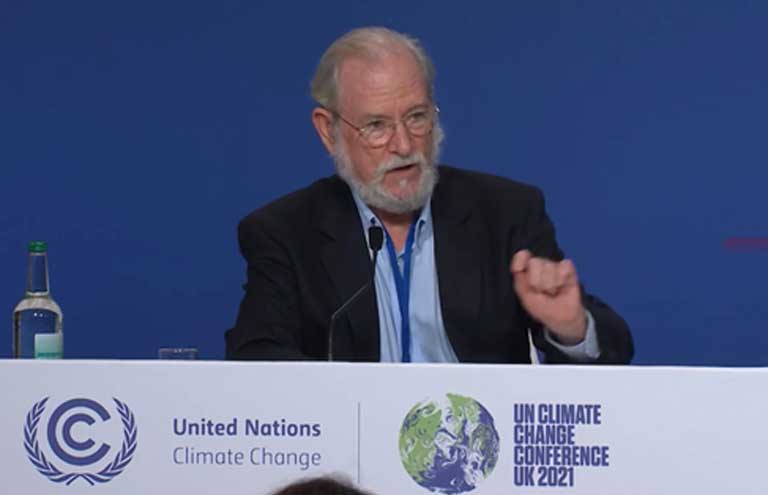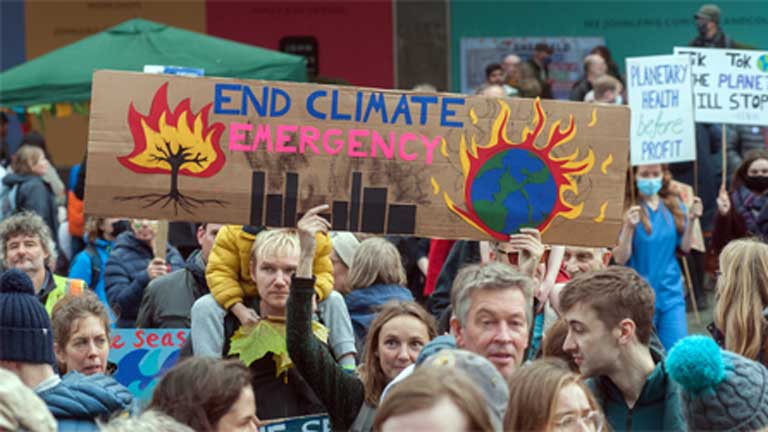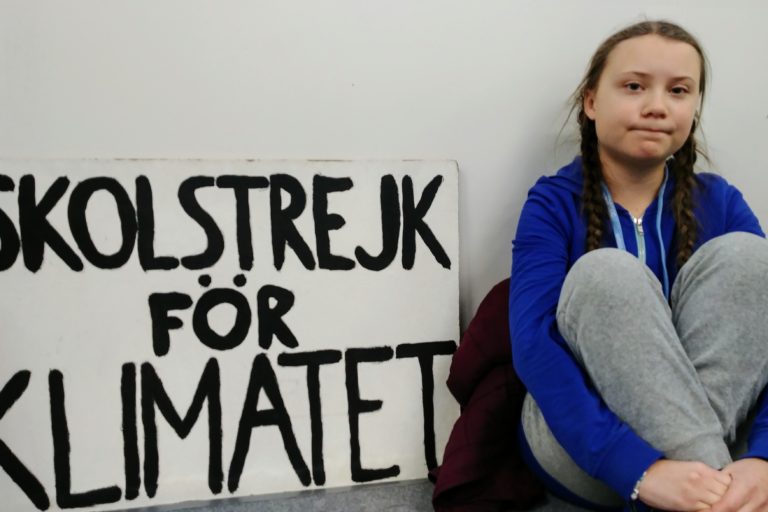- The 2015 Paris Agreement is not a treaty between nations, but rather a voluntary accord between 194 nations signed by their legal representatives. As such, it is not deemed legally binding — preventing nations and corporations from being sued to force them to take legal responsibility for harmful carbon emissions and policies.
- Or at least, that was the accepted legal precedent regarding the Paris accord, as well as declarations and agreements made since 2015 at annual COP summits. This includes this year’s Glasgow U.K. climate conference where major declarations to end global deforestation and sharply curb methane emissions were made.
- However, some 1,800 lawsuits seeking to hold nations and corporations responsible for their climate change pledges and emissions are moving through the worlds’ legal systems. At least one major case has borne fruit: In May 2021, a court in The Netherlands ordered Royal Dutch Shell to slash carbon emissions far faster than pledged.
- It wasn’t international law that decided the case, but basic tort law: a legal obligation to not knowingly injure others. “Rights-based climate litigation is not some kind of scholarly fantasy; rather, it is turning out to be one of the most important tools civil society has to force governments to move more quickly,” says one legal expert.
GLASGOW, Scotland — Regardless of the ultimate outcome of the 26th United Nations climate summit here, one thing is certain: It will end with pledges from scores of countries for enhanced carbon and methane emissions targets, deforestation reductions, and promises of billions in financing to aid vulnerable nations and Indigenous peoples suffering the fallout from climate change.
But those pledges — gathered under the broad umbrella of the 2015 Paris Agreement — are voluntary and legally nonbinding. Or are they? According to a pair of U.S. public-interest attorneys who have been active, visible and vocal during COP26, those national pledges are not as unenforceable as is often assumed.
In what is becoming a new frontier in climate action — akin to the successful movement to get investors, universities and pension funds to divest their fossil fuel holdings — special legal action, taken in local jurisdictions under local law, could end up putting real teeth into the presumably toothless Paris Agreement, along with the upcoming Glasgow accords and declarations to protect forests and reduce methane.
“A pledge is one thing. Actual enforceable law is another. Getting the law enforced is yet another,” said attorney John Fitzgerald, a veteran of U.N. climate meetings dating back to 1992 and now general counsel to Methane Action, a U.S.-based environmental NGO. “This is a moment when it can be done. There are a variety of legal tools that can be used to see that pledges become more binding than simply promises made.”

Dan Galpern, a public interest and environmental law attorney from Eugene, Oregon, teamed up with Fitzgerald here at COP26 for a panel discussion on legal pathways to enforcing voluntary environmental pledges. He recently founded the Climate Protection and Restoration Initiative. Both spoke with Mongabay.
“What is keeping nations or individuals from taking action?” Galpern asked. “Nothing. Nothing except practical and political considerations.”
It’s not like cases aren’t being filed in an attempt to hold parties responsible for their climate pledges; the vast majority just aren’t getting media and public attention. According to the climatecasechart.com data base, some 1,800 lawsuits related to climate change are ongoing in courts around the world. That’s a number bound to grow, and possibly gain legal weight in future.

A Dutch precedent
Perhaps the most famous successful case was decided in The Netherlands last May when a Dutch court ordered fossil-fuel giant Royal Dutch Shell to cut its carbon emissions more than twice as fast as it had promised, reducing them by 45% instead of the originally proposed 20% by 2030.
MilieuDefensie, an environmental consortium, had accused Shell of violating Dutch human rights by undermining the Paris Agreement’s goal of limiting global temperature rise to 1.5° Celsius (2.7° Fahrenheit) over pre-industrial levels.
Shell is not a Paris Agreement signatory, but The Netherlands is. The Dutch court still found the company liable, setting a possible national and international precedent that other environmental groups are now trying to emulate in targeting other global oil producers.
“Here’s what’s interesting,” Galpern said. “It wasn’t international law that got Dutch Shell. It was The Netherlands court system’s basic ‘duty of care’ [requirement], informed by the country’s obligations under Paris. It was basic tort law: Don’t injure other people.”

Climate change impacts: Threat to constitutional rights
John Knox, a professor of international law at Wake Forest University in the United States and a former U.N. special rapporteur on human rights and the environment, has followed these legal challenges closely. (Full disclosure: Knox is on the same faculty as this story’s author). Knox recently wrote the following on an academic listserv:
The NDCs [Nationally Determined Commitments to reduce greenhouse gas emissions made under the Paris Agreement] and other non-legal commitments by the States are increasingly being used in domestic litigation aimed at forcing States to reduce their emissions more rapidly, even though those commitments are not binding by international law… Many of these cases rely on rights-based arguments — that is, claims that the effects of climate change are harming specific rights protected by constitutional law or international human rights law, and that the failure of the government to protect against that harm violates its obligations.
Knox added: “To be clear, these courts are not enforcing Paris directly. But the Paris NDCs, and other non-binding statements and commitments, are being cited as informing the arguments and decisions, because these commitments make clear what States themselves have said is necessary and feasible for them to do.”
As a caveat, Knox noted that rights-based cases would likely face stiff challenges against the world’s two largest polluters: the United States and China.
In the U.S., the landmark climate lawsuit launched in 2015 by 21 young people, known as Juliana v. United States, continues its slow progress toward a possible Supreme Court appeal. The young people argue their constitutional right to life, liberty and the pursuit of happiness was violated by multiple U.S. administrations whose policies and subsidies supported the fossil fuel industry, while knowingly ignoring scientific warnings of climate catastrophe.
Elsewhere, Knox wrote, “rights-based climate litigation is not some kind of scholarly fantasy; rather, it is turning out to be one of the most important tools civil society has to force governments to move more quickly.”
Here in Glasgow, it’s not exactly as if Fitzgerald and Galpern have hung out a law-firm shingle, recruiting from the tens of thousands of potential plaintiffs from nearly 200 countries who are crowding the corridors and attending side events. But Galpern, whose focus and passion suggests a male Erin Brockovich, would not turn any enquiries away.
“I am eager to find a nation willing to stand up and demand that major polluters, those who have laughed all the way to the bank while using the atmosphere as an open and free sewer, to bring a case under the domestic law of that nation, or in the jurisdiction of the polluter. They can be held accountable,” Galpern said.

Obstacles to litigation
Still, legal hurdles stand in the way. Fitzgerald said there are fundamental reasons why vulnerable nations already suffering climate impacts like Fiji, the Marshall Islands, the Maldives, Bhutan or dozens of others are not lining up legal counsel.
“They don’t want to bite the hand that feeds them,” Fitzgerald said. “If they blow the whistle, they fear losing foreign aid or even trade, though in some cases the damage from climate change exceeds whatever money they are receiving. Also, ministers of vulnerable nations may not be fully aware of these legal avenues, and if they are, it’s not cheap to hire lawyers who would be really effective.”
Galpern agrees, but added that in some cases, funds from outside donors or philanthropists could be raised to pay legal fees of developing nations — those countries weary of the developed world’s broken environmental promises who want to file suit.
Fitzgerald pointed out that the 2015 Paris Agreement, and related pledges since then, are not the only targets for litigation. The conservation-focused Convention on Biological Diversity, signed by 150 nations in 1993, has provisions that would support legal action.
Article 3, for example, says: “States have, in accordance with the Charter of the United Nations and the principles of international law … the responsibility to ensure that activities within their jurisdiction or control do not cause damage to the environment of other States or of areas beyond the limits of national jurisdiction.”

Tanya Sanerib, senior attorney for the U.S.-based Center for Biological Diversity, told Mongabay that the convention gets implemented by countries in a variety of ways to protect biodiversity.
“For some, they create legally binding legislation,” Sanerib said, “while others treat treaties as binding at the national level. But still others do neither. It’s truly a patchwork. But within that patchwork, there are definitely options for accountability — like the Dutch Shell case.
“But what’s clear right now is we need action. It’s time to get creative, pull out all the stops, and hold global players accountable in the face of the biodiversity and climate change crises. Life on Earth depends on it.”
Galpern added, “If governments are not going to faithfully execute and carry out their promises, then it falls to citizens or groups in the affected countries to try to do something about it.”
Justin Catanoso, a regular contributor, is a professor of journalism at Wake Forest University in the United States. This is his seventh UN climate summit. Follow him on Twitter @jcatanoso
Banner image: A COP26 protest march in Sheffield, U.K. Photo credit: Tim Dennell on Visualhunt.com.
FEEDBACK: Use this form to send a message to the author of this post. If you want to post a public comment, you can do that at the bottom of the page.
